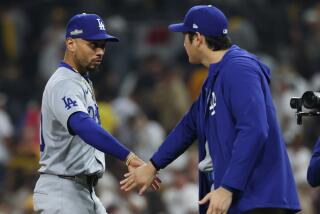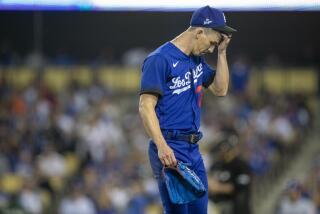BASEBALL /ROSS NEWHAN : Royally Out of Sync in Kansas City
Herk Robinson, the Kansas City Royals’ general manager, describes it as equal parts embarrassment, disappointment and frustration.
“This franchise has never been through anything like it,” he said by phone.
What franchise has?
The Royals’ 1-16 start is second on baseball’s all-time list for futility to the Baltimore Orioles’ 21 consecutive losses at the start of the 1988 season.
It’s still April, but are the Royals already facing five months of playing out the string?
“We haven’t reached that point at all,” Robinson said. “They’ve played hard, the pride is still there and the clubhouse chemistry has been outstanding.
“There’s no question that everything spirals and our confidence has been affected, but the ability to pull out of it is there. We felt this was a club capable of winning the division, and we still do.”
It seems appropriate, however, that the Royals’ only victory came in a game in which they had only one hit.
This team has scored 39 runs through 17 games. Its batting average is .202. Former Angel Wally Joyner, an exception at .318, leads the team in runs batted in with six. Kevin McReynolds and George Brett lead in home runs with two.
On the night they lost to Rick Sutcliffe and the Orioles, 2-1, the starting lineup had a composite average of .182, compared to a composite career average of .289.
Is everything up to date in Kansas City? You bet. Even Royal fans, among the most benevolent and supportive in baseball, have been booing, with their focus on the three players acquired from the New York Mets for Bret Saberhagen--McReynolds (.156), Gregg Jefferies (.227) and Keith Miller (.262).
Robinson still insists it was a deal he had to make, an attempt to rebuild the offense after the loss of free agent Danny Tartabull.
The party line is that the Royals had finished sixth for two consecutive seasons with Saberhagen and had the chance to acquire three everyday players for a pitcher who worked every fifth day and was 13-8 in 1991, 5-9 in 1990.
Manager Hal McRae responded to the signing of Joyner and subsequent Saberhagen trade by saying he had gained a set lineup with a variety of ways to score.
In reality, the Royals traded a two-time Cy Young Award winner and failed to get an impact player, defensive standout or clubhouse leader in return.
With Brett struggling at 38 (he is batting .164, with one hit in his last 32 at-bats) and Joyner already prompting questions about his intensity (“Doesn’t run out ground balls very hard, does he?” said a club executive), it has been left to McRae to attempt to stir clubhouse passions.
McRae tore into his players after Tuesday night’s loss to Sutcliffe, then announced a shake-up:
Jim Eisenreich and Gary Thurman will platoon in right field, McReynolds will move from right to left, Miller will move from left to second base, Terry Shumpert will move from second base to triple-A Omaha, David Howard will move from shortstop to the bench and then the disabled list, veteran Curtis Wilkerson will replace Howard, Mike Boddicker will be sent to the bullpen and Mike Magnante will replace Boddicker in a rotation that has paid a price for the lack of offense.
Kevin Appier, for example, has a 1.27 earned-run average through four starts but is 0-2, the Royals having lost three of those starts by scores of 2-1, 1-0 and 1-0.
Robinson has been left to feel the heat of several fires.
--Predecessor John Schuerholz, now with the Atlanta Braves, was National League executive of the year in 1991.
--Kevin Seitzer, released by the Royals in spring training, was signed by the Milwaukee Brewers and leads the American League in hitting.
--Fans wonder if there was a strong enough attempt to retain Tartabull’s power and bemoan the loss of Saberhagen as the three former Mets struggle.
Said Robinson: “If I had to look back on anything, though I don’t think it would have changed my approach to the trade, it’s that I really didn’t put enough stock in the argument that it takes time to adjust to a new league. I don’t know if it’s psychological or not, but I’m seeing that there’s some validity to it.”
In other words, Jefferies, McReynolds and Miller will improve with time, Robinson says, although he acknowledged that there has been too much focus on the trade, that the slump is basically team-wide and that proven players aren’t performing.
Is time with or against the Royals, who are attempting to recoup during a four-city, 10-game trip?
Relief ace Jeff Montgomery, with no games to save, said the club’s record is akin to “one and infinity,” and that every day is painful. How painful? How frustrating to leave the park every night on the short end, the very short?
“Well,” Robinson said, “I think it’s been easier to leave than to come back the next day.”
A FAT CHANCE
In the visiting manager’s office at Dodger Stadium the other day, Lou Piniella of the Cincinnati Reds said today’s players might spend too much time working on conditioning.
“I played until I was 40 and never worked out during the winter,” Piniella said. “I put my glove in my locker on the last day of the season and never touched it again until the first day of spring training.
“I played a little golf and racquetball, had a couple cocktails and rested my body. I may not have looked as good as these players, but I wasn’t showing off at the beach. I didn’t have to look like Apollo.”
Piniella was responding to the rash of injuries during the first two weeks of the season. The Reds played the Dodgers without infielders Hal Morris, Barry Larkin and Chris Sabo. Pitcher Jose Rijo is on the disabled list because of an elbow problem that could be serious, if rest isn’t the answer. More than 90 players are on the disabled lists of the 26 teams.
“I never heard of body fat when I played,” Piniella said. “I think the clubs are guilty of jumping on players when they report two or three pounds overweight. What the hell is spring training for? Why the hell do bears put on a winter coat?
“There’s no question these athletes are better conditioned, but they’re also more prone to injuries. It’s a demanding sport and the body needs rest. You play 162 games with constant travel, and all the AstroTurf makes it even tougher.”
Piniella didn’t bring it up, but the record shows that he, too, was on the disabled list four times during his 17-year major league career, which was about once every four years.
There are players--some suffering from “contractitis”--who are on that many times in one or two years.
Piniella laughed and said that in his final years as a player with the New York Yankees, owner George Steinbrenner would assign a trainer to oversee Piniella’s workouts. Instead, Piniella supervised the trainer’s workouts.
“I’d bet a bottle of cognac (on whether) he could run the obstacle course, and I’d sit there and time him,” Piniella said.
PALER HOSE
The Chicago White Sox can do little but be philosophical about the loss of shortstop Ozzie Guillen, who suffered torn knee ligaments and is sidelined for the season.
General Manager Ron Schueler said he is suddenly “the most popular guy in town” with clubs calling to offer their shortstops, but he intends to go with Guillen’s backup, the 5-foot-7 Craig Grebeck, who played at Lakewood High and Cal State Dominguez Hills.
Said Manager Gene Lamont: “People don’t realize how good a player Ozzie is, but we probably have as good a replacement as anybody does. Craig has more pop than Ozzie, and to me he’ll be the kind of shortstop Jay Bell is.”
Lamont watched the Pirates’ shortstop while coaching in Pittsburgh. Bell had 24 errors last season but batted .270 with 16 home runs, 67 runs batted in and 27 sacrifice bunts.
Grebeck batted .281 with six home runs in 224 at-bats, but he lacks Guillen’s gold glove and scouts have questioned his physical stamina if tested on a daily basis.
Among the shortstops who could be available at the right price are Felix Fermin of the Cleveland Indians, Jose Uribe of the San Francisco Giants, Ozzie Smith of the St. Louis Cardinals and Shawon Dunston of the Chicago Cubs.
But Schueler, having already traded for Steve Sax and George Bell and lost a draft choice with the signing of Kirk McCaskill as a free agent, said there is only so far he can go, although White Sox hopes might hinge on the decision.
In the meantime, the White Sox are suddenly faced with one other important decision involving Guillen, who has two option years remaining at $2 million and $2.1 million on his contract.
Do the White Sox, uncertain of the knee’s long-range stability, protect Guillen or expose him to the expansion draft? Would the Colorado Rockies and Florida Marlins take a chance if he were exposed?
STYLING
Barry Bonds has hit seven home runs and driven in 15 runs in helping generate Pittsburgh’s 14-3 start, but his slow home run trot has resulted in pay-backs.
Bonds has been hit twice, by Mitch Williams of the Philadelphia Phillies and former Dodger John Wetteland of the Montreal Expos, in what seemed retaliation for his trot.
“I am what I am,” Bonds said. “You hit a home run, you get four bases. I don’t care if they send a limo to pick you up. Nobody changes my style. Nobody intimidates me.”
And of the Pirates’ surprisingly strong start after the departure of Bobby Bonilla, John Smiley and Bill Landrum, a role player named Kirk Gibson said:
“It’s almost too good to be true, but the day will come when we’re struggling, and then we’ll find out how good we are. It all seems easy when you’re winning.”
More to Read
Go beyond the scoreboard
Get the latest on L.A.'s teams in the daily Sports Report newsletter.
You may occasionally receive promotional content from the Los Angeles Times.










